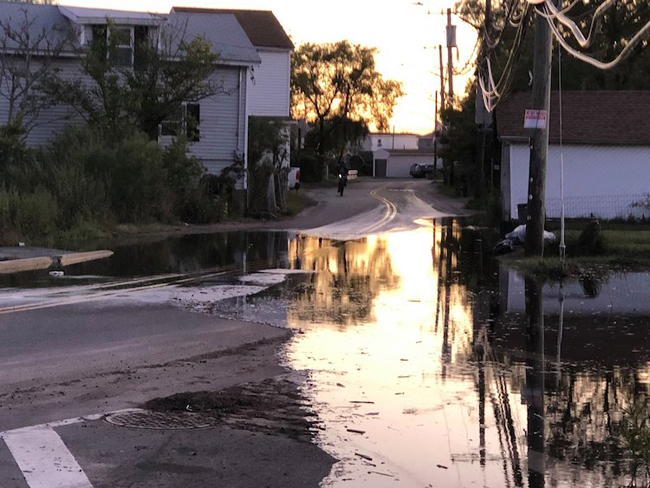
Flooding in Howard Beach, New York. Credit: Jamaica Bay Community Flood Watch Project
— Published by Alison Simko, WaterWire Editor
Waterwire, a product of the Waterfront Alliance, features news and stories about the waterways of New York and New Jersey
BROOKLYN, NY, December 5, 2019 - In New York and New Jersey, citizen scientists are making crucial contributions to the understanding of flooding, sea level rise, and the effects of climate change. Photographs and data submitted by volunteers who live in coastal communities help improve forecasts and contribute essential information to mitigation plans. Just as important, the work amplifies the voices of the community.
In New York’s Jamaica Bay watershed, Helen Cheng, New York Sea Grant‘s coastal resilience specialist in a partnership with the Science and Resilience Institute, runs the Jamaica Bay Community Flood Watch program. Program partners include Stevens Institute of Technology, New York City Office of Emergency Management, New York City Mayor’s Office of Resiliency, and the U.S. Forest Service Urban Field Station. Ms. Cheng explains that on-the-ground data about floods supplied by community volunteers informs and improves computer models and maps created by research institutions and government agencies. In turn, the program provides residents with information and resources about flooding.
Ms. Cheng works with volunteers from three communities: Hamilton Beach/Howard Beach, Far Rockaway, and Broad Channel. After introductory training in taking photographs and noting data that best explain the state of flooding, the volunteers are ready to participate. “A lot of the work revolves around preparedness,” Ms. Cheng says. “If flooding is forecasted, we notify people and tell them when flooding will be most severe. We tell them to be vigilant and be aware of resources provided by the National Weather Service.”
In New Jersey, Professor Tom Herrington, associate director of the Urban Coast Institute at Monmouth University, guides coastal communities as they address increasing floods due to storms, sea level rise, and high tides. Earlier this year in Ocean City, Mr. Herrington and other partners, including New Jersey Sea Grant, the New Jersey Department of Environmental Protection, and the online crowdsourcing platform iSeeChange, engaged the community to record local floods and delve into what caused those floods. More than 100 people collected rain data and photographed rising waters. “We discussed with the community what the sources of flooding were and what could be done about it,” Professor Herrington said. “Through those conversations, we were able to dig deeper into flood issues that barrier islands face in climate change. What’s been interesting is that by engaging the citizens directly in the science, they get an appreciation of the broader picture of climate change, and they become more receptive to discussing it. At every meeting, there’s a handful of skeptics, but over time, even those skeptics acknowledge that the floods are increasing. It’s been a great program and pleasure to work with the community.”
Elsewhere in the Garden State, a group of Jersey Shore communities who got together in response to Hurricane Sandy recently installed a webcam for community members to track floods in Sea Isle City. The group, called the New Jersey Coastal Coalition, promises more webcams will be implemented in other parts of the Jersey shore. In another citizen science effort that helps communities understand their risks while at the same time contributing important data to scientific research, Lisa Auermuller, the Watershed Coordinator for the Jacques Cousteau National Estuarine Research Reserve in Tuckerton, New Jersey, and affiliated with the Climate Institute at Rutgers University, has been crowdsourcing information on exceptionally high tides called King Tides. When King Tides are predicted, the word goes out via social media to #CapturetheKing, and New Jersey residents respond with photographs documenting the tides and floods in their area.
Back in Jamaica Bay, Ms. Cheng is looking for more citizen scientists to join the Flood Watch program. She is also seeking participants to talk about how flooding has impacted the way they live. Contact her at helen.cheng@cornell.edu if you’d like to contribute data and share your story. The program may soon expand beyond Jamaica Bay; perhaps to Coney Island Creek, Red Hook, the Bronx, and elsewhere.
“As the conversation about flooding and sea level rise gets louder, and attention is drawn to how this will impact communities along the coast, there needs to be a record of how often floods are happening and how it is impacting communities now,” Ms. Cheng said.
More Info: New York Sea Grant and SRIatJB
The Science and Resilience Institute @ Jamaica Bay
(SRIJB) is a research center focused on enhancing environmental,
social, and economic resilience in communities of Jamaica Bay funded by
the Rockefeller Foundation and the City of New York.
New York Sea Grant (NYSG), a cooperative program of Cornell University
and the State University of New York (SUNY), is one of 34 university-based
programs under the National Oceanic and Atmospheric Administration’s
National Sea Grant College Program.
Since 1971, NYSG has represented a statewide network of integrated
research, education and extension services promoting coastal community
economic vitality, environmental sustainability and citizen awareness
and understanding about the State’s marine and Great Lakes resources.
Through NYSG’s efforts, the combined talents of university scientists
and extension specialists help develop and transfer science-based
information to many coastal user groups—businesses and industries,
federal, state and local government decision-makers and agency managers,
educators, the media and the interested public.
The program maintains Great Lakes offices at Cornell University, SUNY
Buffalo, SUNY Oswego and the Wayne County Cooperative Extension office
in Newark. In the State's marine waters, NYSG has offices at Stony Brook
University in Long Island, Brooklyn College and Cornell Cooperative
Extension in NYC and Kingston in the Hudson Valley.
For updates on Sea Grant activities: www.nyseagrant.org has RSS, Facebook, Twitter, and YouTube links. NYSG offers a free e-list sign up via www.nyseagrant.org/nycoastlines for its flagship publication, NY Coastlines/Currents, which is published quarterly. Our program also produces an occasional e-newsletter,"NOAA Sea Grant's Social Media Review," via its blog, www.nyseagrant.org/blog.